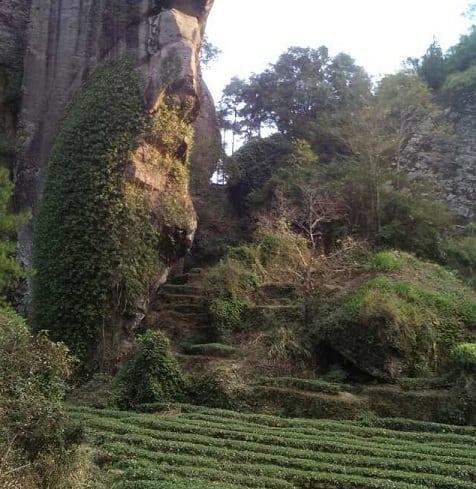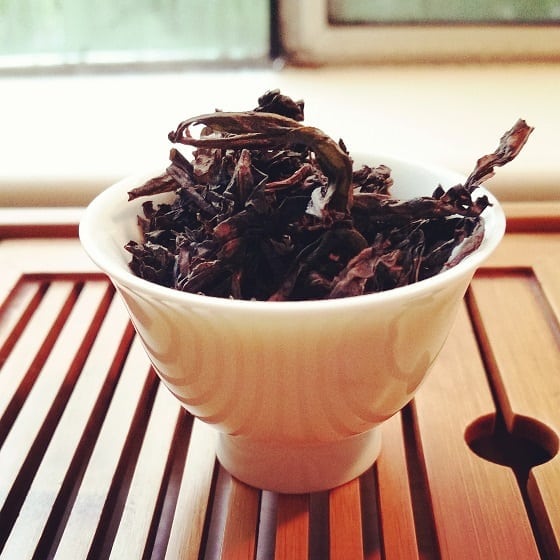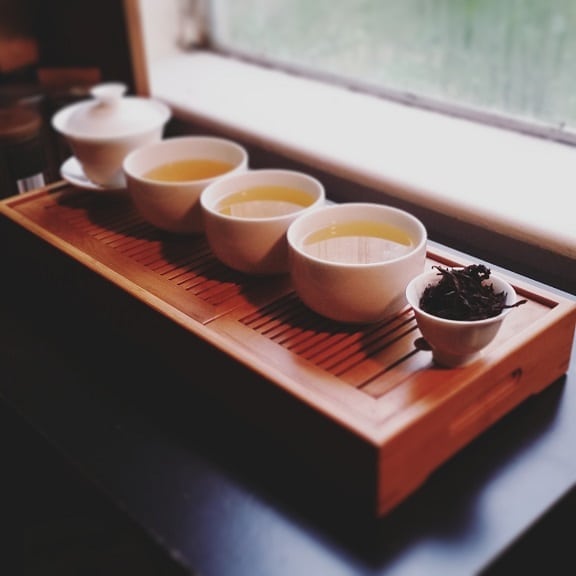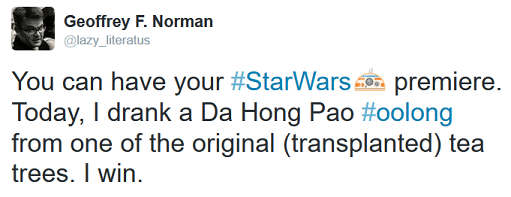Da Hong Pao literally means “Big Red Robe” in Chinese, and it has a very big history. There are no less than five origin stories for this particular kind of tea. The most famous, exported legend deals with an emperor (or imperial official) whose mother was ill, and teas produced from Da Hong Pao trees cured her of her illness. In gratitude for this, the official/monarch covered the four original trees in “big red robes” to signify their importance.

In China, however, the more prevailing origin story involves a scholar. He had a debilitating stomach ache, and Qi Dan oolong (as it was known back then) cured him of it. After passing some high level exam in Beijing, he returned to the Wuyi Mountain region of Zhengyan, and cloaked the blessed trees in the aforementioned big red robes. Hence the name of the tea produced from said plants was changed.
Not as epic as the emperor version, but far more believable.
To confuse the issue even further, there are also multiple sites that claim to have the “original” Qi Dan (now Da Hong Pao) cultivar trees. It is generally believed, however, that true Da Hong Pao originates from the Zhengyan (or “Middle Mountain”) region of Wuyi.

As of 2006, however, picking tea leaves from the remaining original Da Hong Pao trees is impossible. Due to their sacred status – and to the fact that they might be slowly dying – plucking is no longer allowed. And any aged Da Hong Pao oolongs out there plucked from the original trees fetch a very high price. That said, there is an equally authentic alternative.
There were trees from the same site that were transplanted to other growing areas within Zhengyan. Da Hong Pao oolongs plucked and produced from these trees are called Mu Ben (or “Mother Tree) Da Hong Pao. And they also fetch a high asking price. I never thought I would try something this rare, even in all my years of tracking down rare teas. But Four Seasons Tea gave me such an opportunity.
For the sake of full disclosure, I have to confess . . . that I’m not really a fan of Da Hong Pao. It falls in that “yancha” category of oolongs that I don’t quite favor. That being, it has a tendency to taste like rocks. Worse off, many Paos I’ve tried were heavily-roasted . . . making it taste like burnt rocks. So, honored – though I was – for the opportunity to try this rare version, I didn’t think I was going to be the best person for it.
All fears were eliminated on sight and smell.

The leaves for this Da Hong Pao looked like what I expected. They were brown to soot-black, curly, and medium-sized. What I wasn’t prepared for was the aroma. Paos past have had a very charcoal aroma and not much else. This had some of the requisite roast to the aroma, but with a bit of something extra – sweetness and Dan Cong-ish tartness on the back-whiff.
For brewing, I approached this as I would any other oolong. I brought water to a boil, and let it sit for a few minutes. Then I put roughly a flat tablespoon of leaves in a gaiwan. Lastly, I prepped three successive infusions – each at thirty seconds, and rose the last one to forty seconds.
All three infusions brewed a lovely medium yellow with a comfortable, roasted nutty aroma. Not much in the way of nuance on smell, but as for taste . . . ? Where has this tea been all my life?!
Hold on, I’m trying to get the order of taster notes straight in my head. Damn it, it’s not working. Here goes . . .

The first sip on the first infusion reminded me of liquor. Like, actual liquor – rum, to be precise. Without that whole turpentine sensation. That gradually acquiesced to a feeling of toast. No, I wasn’t tasting toast, I felt like a piece of toast. A delicious piece of toast, lathered in clotted cream that – for some reason – was also toasty.
By the second infusion, I was able to pin things down a little more. The intro was chestnutty, but the remainder of the sip was all vanilla-honey-lathered stonefruit and angels throwing flowers on a gold-gilded bed. Crap, still not concise enough.
Third infusion! It tasted like amber. No, not a girl named Amber, the color amber. I’m sure it has a taste, and this is it. The infusion was perfect; no rough edges to speak of. It was the harp song of harmony. No particular notes stuck out from the others. All elements just fused together perfectly into a Buddhist angel chorus chiming, “PAO!”
The day I finally dove into this, the social media sphere was all ablaze about early Star Wars: The Force Awakens news. And I couldn’t have cared less. I tea-drunkenly tweeted . . .

Smug much? Yer damn right, and with good reason. Not much else could top that, except having an ’05 Pao from one of the sacred trees. On the Millennium Falcon set. But as far as lofty goals go, this one tasted perfect enough.
A quick announcement!
Four Seasons Tea are offering 12% off all of their wares for the next couple of weeks. All one has to do is enter this code: FOURSEASONS12
This isn’t a plug, but I can say that from what I’ve had so far . . . their Wuyi oolongs are worth it. And that’s coming from a guy that’s been very vocal about his anti-Wuyi leanings of late. So, give it a go.
Leave a Reply